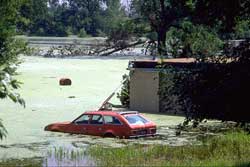Earth Sciences (also referred to as Geosciences), which deals with basic issues surrounding our planet, plays a vital role in the area of energy and raw materials supply.
Earth Sciences comprises subjects such as geology, geography, geological informatics, paleontology, mineralogy, petrography, crystallography, geophysics, geodesy, glaciology, cartography, photogrammetry, meteorology and seismology, early-warning systems, earthquake research and polar research.

A greater number of large “planetary sized waves” in the atmosphere that move from the lower atmosphere into the upper atmosphere were responsible for the smaller Antarctic ozone hole this fall, according to NASA researchers. The September 2002 ozone hole was half the size it was in 2000. However, scientists say that these large-scale weather patterns in the Earth’s atmosphere are not an indication that the ozone layer is recovering.
Paul Newman, a lead researcher on ozone at NASA’

The broad-scale warming expected from increased greenhouse gases may actually sap the strength of a typical El Niño, according to researchers at the National Center for Atmospheric Research (NCAR) in Boulder, Colorado. In contrast, the average El Niño during the last ice age may have packed more punch than today’s. The scientists have examined the past and future behavior of El Niño using a sophisticated computer model of global climate. They present their results this week at the annual meeting

Nearly a month has passed since the wounded tanker Prestige spilled thousands of tons of heavy oil into the Atlantic and fouled dozens of Spanish beaches. But anxious residents of coastal Spain and Portugal remain on high alert – wondering where and when the noxious crude will wash ashore next.
In recent years, tanker accidents have ruined fisheries and tourist beaches from Alaska to France. But do oil spills always have to end in catastrophe? Perhaps the most vulnerable beaches and coastal

An especially cold winter in Europe, lots of snow in Scandinavia or lots of rain in the Mediterranean are all symptoms of what meteorologists call the North Atlantic Oscillation, but a group of Penn State researchers has gone beyond the symptoms to try to decipher the dynamics of this atmospheric pattern.
“Some scientists argue that the impact of the NAO on global climate is comparable to El Nino,” says Dr. Sukyoung Lee, associate professor of meteorology. “However, most of the scientific co

DOE News Release Embargoed for release December 6, 2002 INEEL geoscientist to present NAPL contaminant modeling advance at AGU Meeting By modifying the mathematical theory describing the relationship between permeability, saturation, and pressure in a multiple fluid system, researchers can now more accurately predict the movement of non-aqueous phase liquid (NAPL) contaminants in the subsurface. New calculations account for residual NAPL that remains in the vadose zone-forming a long-term source f

The direct injection of unwanted carbon dioxide deep into the ocean is one suggested strategy to help control rising atmospheric carbon dioxide levels and mitigate the effects of global warming. But, like the problems associated with the long-term storage of nuclear waste, finding a safe place to sequester the carbon may be more difficult than scientists first anticipated.
Because the atmosphere interacts with the oceans, the net uptake of carbon dioxide and the oceans’ sequestration capac